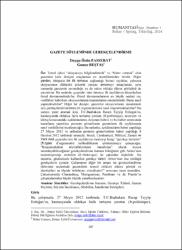| dc.contributor.author | Passerat, Duygu Öztin | |
| dc.contributor.author | Beştaş, Gamze | |
| dc.date.accessioned | 2017-06-05T08:22:03Z | |
| dc.date.available | 2017-06-05T08:22:03Z | |
| dc.date.issued | 2014 | |
| dc.identifier.uri | https://hdl.handle.net/20.500.11776/1318 | |
| dc.description.abstract | Temel işlevi “okuyucuyu bilgilendirmek” ve “haber vermek” olan gazeteler kitle iletişim araçlarının en önemlilerinden biridir. Diğer yandan, okuyucu ile ilk temasın sağlandığı birinci sayfalar, yalnızca okuyucunun dikkatini çekerek satışını arttırmayı amaçlamaz, aynı zamanda gazetenin savunduğu ya da yakın olduğu dünya görüşünü de yansıtırlar. Bu nedenle, gazeteler ister istemez ilk sayfalarını düzenlerken öznel davranmaktadırlar. Öznel davranmalarının en büyük nedeni ise, verdikleri haberlere okuyucularının inanmalarını istemeleridir. Bunu nasıl yapmaktadırlar? Diğer bir deyişle, gazeteler okuyucularını inandırmak için gerekçelendirmelerini (fr.argumentation) nasıl oluşturmaktadırlar? Bu soruya yanıt aramak için, T.C.Başbakanı Recep Tayyip Erdoğan’ın, kamuoyunda oldukça fazla tartışma yaratan (fr.polémique), sezaryen ve kürtaj konusundaki açıklamalarına dayanan haberi ve bu haber sonrasında kadınların yaptıkları protesto gösterilerini gazetelerin ilk sayfalarında nasıl verdiklerini inceleyeceğiz. Bu nedenle, açıklamaların haber yapıldığı 27 Mayıs 2012 ve ardından protesto gösterilerinin haber yapıldığı 4 Haziran 2012 tarihinde sırasıyla, Sözcü, Cumhuriyet, Milliyet, Zaman ve Yeni Akit gazetelerinin ilk sayfalarını inceleyip hangi “gerekçe türlerini” (fr.types d’arguments) kullandıklarını çözümlemeye çalışacağız. “Karşımızdakini söylediklerimize inandırma” olarak kısaca tanımlayabileceğimiz gerekçelendirme kuramı bildiğimiz gibi Aristo’nun kuramlaştırdığı sözbilim (fr.rhétorique) ile yakından ilişkilidir. Bu nedenle, günümüzde kullanılan gerekçe türleri Aristo’nun öne sürdüğü gerekçelerle aynıdır. Çalışmanın diğer bir amacı ise gerekçelendirme türlerinin seçiminde gazetelerin temsil ettikleri dünya görüşü ve ideolojileri ne ölçüde belirleyici olmaktadır?” sorusuna yanıt aramaktır. Çalışmamızda Charaudeau, Maingueneau, Perelman ve de Plantin’in çalışmalarından büyük ölçüde yararlanılacaktır. | en_US |
| dc.description.abstract | The first and fundamental aim of the newspapers is to inform, enlighten and impart readers. While carrying out these principal functions, the newspapers sometimes stay far away from being objective and impartial depending upon their worldviews, and therefore publish news subjectively. This can be seen on the ordering of the news front pages and the headlines of the newspapers. This study aims at tackling the prime minister of the Republic of Turkey Recep Tayyip Erdogan’s controversial speech dated May 27, 2012 about abortion and caesarean section and the news protesting his speech by showing how the media represented all this polemic on June 4, 2012 through the analyses of the various types of argumentation. This study starts with the justification types proposed by Christian Plantin, one of the most famous theoreticians of the argumentation theory, and proceeds to delve into exemplifying them in the corpus of the texts. As the corpus consists of the media texts, the theoretical background is based on discourse analyses of linguistssuch as Charadeau, Maingueneau, Burger, and their publications. The initial step is to dwell on the question of “what is the media discourse?” by highlighting which strategies, techniques and tricks are used by the media to increase their circulation and credibility in their preparation of the headlines and the front page which is the first step to involve readers. Hence, it could be stated that the main aim of this article is to probe the question of “to what extent the media ideology and worldviews have shaped and impacted the argumentative types forming the basis of the arguments and justifications defined as the ways to make people believe in what we say?” In this respect the front pages of Sözcü, Cumhuriyet, Milliyet, Zaman and Yeni Akit dated May 27, 2012 and June 04, 2012 will be tackled. | en_US |
| dc.language.iso | tur | en_US |
| dc.publisher | Namık Kemal Üniversitesi, Fen-Edebiyat Fakültesi | en_US |
| dc.rights | info:eu-repo/semantics/openAccess | en_US |
| dc.subject | Gerekçelendirme Kuramı | en_US |
| dc.subject | Gerekçe Türleri | en_US |
| dc.subject | Discourse | en_US |
| dc.subject | Discourse Analysis | en_US |
| dc.subject | Journalistic Discourse | en_US |
| dc.subject | Argumentation Theory | en_US |
| dc.subject | Argument | en_US |
| dc.title | GAZETE SÖYLEMİNDE GEREKÇELENDİRME | en_US |
| dc.title.alternative | ARGUMENTATION THEORY IN JOURNALISTIC DISCOURSE | en_US |
| dc.type | article | en_US |
| dc.relation.ispartof | HUMANITAS - Uluslararası Sosyal Bilimler Dergisi | en_US |
| dc.department | Tekirdağ Namık Kemal Üniversitesi Dergileri | en_US |
| dc.authorid | 173822 | en_US |
| dc.authorid | 223556 | en_US |
| dc.identifier.volume | 2 | en_US |
| dc.identifier.issue | 3 | en_US |
| dc.identifier.startpage | 187 | en_US |
| dc.identifier.endpage | 202 | en_US |
| dc.relation.publicationcategory | Makale - Ulusal Hakemli Dergi - Kurum Öğretim Elemanı | en_US |



















